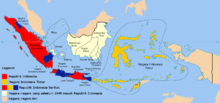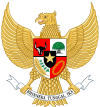State of East Indonesia
| State of East Indonesia Negara Indonesia Timur | |||||||||
|---|---|---|---|---|---|---|---|---|---|
| State of Indonesia | |||||||||
| 1946–1950 | |||||||||
 The State of East Indonesia shown in gold as Negara Indonesia Timur | |||||||||
| Anthem | |||||||||
| Indonesia Raya | |||||||||
| Capital | Makassar | ||||||||
| Area | |||||||||
• 1946 | 349,088 km2 (134,784 sq mi) | ||||||||
| Population | |||||||||
• 1946 | 10,290,000 | ||||||||
| Legislature | |||||||||
• Upper house | Provisional Senate | ||||||||
• Lower house | Provisional Representative Body | ||||||||
| History | |||||||||
• State Established | 24 December 1946 | ||||||||
• State dissolved | 17 August 1950 | ||||||||
| |||||||||
The State of East Indonesia (Indonesian: Negara Indonesia Timur, old spelling: Negara Indonesia Timoer) was a post-World War II federal state (negara bagian) formed in the eastern Dutch East Indies by the Netherlands. It was established in 1946, became part of the United States of Indonesia in 1949 at the end of the Indonesian National Revolution, and was dissolved in 1950 with the end of the USI. It comprised all the islands to the east of Borneo (Celebes, and the Moluccas, with their offshore islands) and of Java (Bali and the Lesser Sunda Islands).
History
The Dutch authorities, after various changes to the administration of the eastern islands of the East Indies, established the Great East region in 1938.[1] Four years later, the Japanese invaded, and this area was placed under the control of the Imperial Japanese Navy.[2] Following the Japanese surrender and the Indonesian declaration of independence in August 1945, Indonesian republicans began fighting to secure Indonesian independence from Dutch colonial control. However, Dutch administrators backed by Australian troops arrived in the area previously controlled by the Japanese Navy, and prevented republicans from establishing an administration.[3]
From 16–25 July 1946, the Dutch organised a conference in the town of Malino on Celebes (Sulawesi) as part of their attempt to arrange a federal solution for Indonesia. The Malino Conference resulted in plans for a state in Borneo and another for East Indonesia (then called the "Great East"),[4] areas where the Dutch held both de facto and de jure control.[5] Later that year, Republic of Indonesia agreed to the principle of a federal Indonesia with the Linggadjati Agreement of 15 November.[6][7] The Denpasar Conference of 18–24 December was held to work out the specifics of a state to be called the State of the Great East. (Indonesian: Negara Timoer Besar).[8][9][10] That state was established on 24 December and, on 27 December, renamed the State of East Indonesia (Negara Indonesia Timoer or NIT which some opponents joked stood for negara ikoet toean or "state which goes along with the master", i.e. the Dutch[2]).
With the realisation of the United States of Indonesia on 27 December 1949, East Indonesia became a constituent of the new federation. In much of Indonesia, the federal USI was seen as an illegitimate regime foisted on the islands by the Dutch, and many of the federal states began to merge with the Republic of Indonesia.[11] However many in East Indonesia, with its non-Javanese population and greater number of Christians, opposed moves toward a unitary state.[11] East Indonesia had already dealt with the "Twelfth Province" secessionist movement in Minahasa in 1948.
The formation of East Indonesia's last cabinet in May 1950 with the intention of dissolving the state into the Republic of Indonesia led to open rebellion in the largely Christian Moluccas and the proclamation of an independent Republic of the South Moluccas (RMS).[11] The USI was dissolved on 17 August 1950 and the rebellion in the Moluccas was crushed in November of the same year.[11]
Government
The Denpasar Conference of 18–24 December 1946 approved the Regulations for the Formation of the State of East Indonesia (Peratoeran Pembentoekan Negara Indonesia Timoer) which supplemented the 1927 Dutch colonial law and established the provisional governmental framework of the new state until a constitution could be approved. Although the draft constitution was passed by the legislative on 1 March 1949, it was never adopted and the 1946 regulations remained n place until the state was dissolved.[12][13] The state was to have an executive president who would appoint a cabinet and a legislature. A number of powers were explicitly reserved for the future United States of Indonesia, of which East Indonesia would be a constituent member.[14]
President

Balinese nobleman Tjokorda Gde Raka Soekawati was elected president (presiden) at the Denpasar Conference that established the state, and held that position for the duration of the state's existence (24 December 1946 – 17 August 1950).[15][16]
Legislature
The Provisional Representative Body for the State of East Indonesia (Dewan Perwakilan Sementara Negara Indonesia Timoer), initially consisting of the 70 participants of the Denpasar Conference, opened its first session on 22 April 1947 in the presence of Lieutenant Governor-General of the Dutch East Indies Hubertus van Mook. In May 1949, following elections, a Provisional Senate was established[17][18]
Prime ministers and cabinets

The state had a parliamentary cabinet appointed by the president but much real power remained with the Dutch East Indies authorities.[19]
- 13 Jan 1947 – 2 Jun 1947 — Nadjamoedin Daeng Malewa – First Cabinet
- 2 Jun 1947 – 11 Oct 1947 — Nadjamoedin Daeng Malewa – Second Cabinet
- 11 Oct 1947 – 15 Dec 1947 — Warouw Cabinet
- 15 Dec 1947 – 12 Jan 1949 — Ide Anak Agung Gde Agung – First Cabinet
- 12 Jan 1949 – 27 Dec 1949 — Ide Anak Agung Gde Agung – Second Cabinet
- 27 Dec 1949 – 14 Mar 1950 — J.E. Tatengkeng Cabinet
- 14 Mar 1950 – 10 May 1950 — D. P. Diapari Cabinet
- 10 May 1950 – 17 Aug 1950 — J. Poetoehena Cabinet
Administration
The State of East Indonesia was divided into five residencies which were in turn divided into districts (afdeling) and subdistricts (onderafdeling), an administrative structure inherited from the Dutch.[20] Within the residencies were 13 autonomous regions.[21] These regions, listed in Article 14 of the Regulations for the Formation of the State of East Indonesia (Peratoeran Pembentoekan Negara Indonesia Timoer), were South Celebes, Minahasa, Sangihe and Talaoed, North Celebes, Central Celebes, Bali, Lombok, Soembawa, Flores, Soemba, Timor and surrounding islands, South Moluccas, and North Moluccas.[21] The residencies were to be eliminated after the construction of functioning administration in the 13 regions.[21]
Complicating this structure was the fact that
More than 75% of the State of East Indonesia comprised autonomous regions, in total 115 autonomous regional governments under the rule of rajas (swaprajas). The position of these autonomous governmental heads was regulated by what were called korte verklaring (short-term declarations) and lange kontrakten (long-term contracts); these were actually intended as a recognition by the Dutch Indies Government of the special position of the rajas, whose power to govern the autonomous regions was handed down from one generation to the next.[22]
The Autonomous Region Regulation of 1938 gave the swaprajas wide de jure autonomy but most of the rajas were puppets of Dutch administrators.[22]The State of East Indonesia sought to curtail the power of these raja-ruled regions, but the Regulations for the Formation of the State of East Indonesia obliged the state to recognise their special status.[23]
The remaining area of the state not part of the swaprajas comprised directly governed regions (rechtstreeks bestuurd gebied).[24] Directly governed areas included Minahasa, the South Moluccas, Gorontalo, the districts of Macassar and Bonthain, and Lombok.[24]
Residencies and autonomous regions

The following were the residencies and their autonomous regions.[21]
- North Celebes (Soelawesi Oetara)
- South Sulawesi (Soelawesi Selatan)
- South Celebes
- Bali-Lombok
- Moluccas (Maloekoe)
- North Moluccas (Maloekoe Oetara)
- South Moluccas (Maloekoe Selatan)
- Timor
See also
Notes
- ^ Cribb 2000, pp. 130–131.
- ^ a b Ricklefs 2001, p. 276.
- ^ Ricklefs 2001, p. 348.
- ^ Anak Agung 1995, p. 107.
- ^ Anak Agung 1995, p. 97.
- ^ Anak Agung 1995, p. 112.
- ^ Reid 1974, p. 96.
- ^ Anak Agung 1995, p. 117.
- ^ Putra Agung 2007, p. 37.
- ^ Kahin 1952, p. 364.
- ^ a b c d Ricklefs 2001, p. 285.
- ^ de Jong 1994, pp. 1–2.
- ^ Schiller 1955, pp. 97–98.
- ^ Anak Agung 1995, p. 163.
- ^ Anak Agung 1995, p. 131.
- ^ Anak Agung 1995, p. 120.
- ^ Anak Agung 1995, pp. 153, 591–592.
- ^ Wehl 1948, p. 164.
- ^ Anak Agung 1995, p. 146.
- ^ Anak Agung 1995, p. 147.
- ^ a b c d Anak Agung 1995, p. 180.
- ^ a b Anak Agung 1995, p. 121.
- ^ Anak Agung 1995, p. 166.
- ^ a b Anak Agung 1995, p. 181.
References
- Ide Anak Agung Gde Agung (1996) [1995]. From the Formation of the State of East Indonesia Towards the Establishment of the United States of Indonesia. Translated by Owens, Linda. Yayasan Obor. ISBN 979-461-216-2.
- Cribb, Robert (2000). Historical Atlas of Indonesia. Curzon Press. ISBN 0-7007-0985-1.
- de Jong, Christiaan G.F. (1994), "Religion and state in Negara Indonesia Timur. The question of religion in the Parliament of the State of East Indonesia in 1949, illustrated by the situation on Bali" (PDF), Documentatieblad voor de Geschiedenis van de Nederlandse Zending en Overzeese Kerken (Journal for the History of Dutch Mission and Overseas Churches, 1/2, translated by Daalder-Broekman, Truus
- Kahin, George McTurnan (1952), Nationalism and Revolution in Indonesia, Cornell University Press
- Putra Agung. "Yayasan Masyarakat Sejarawan Indonesia". Jurnal sejarah: pemikiran, rekonstruksi, persepsi. 13 (2007) ISSN 1858-2117. (in Indonesian)
- Reid, Anthony J.S (1974), The Indonesian National Revolution, 1945 1950, Hawthorn, Victoria, Australia: Longman, ISBN 0-582-71047-2
- Ricklefs, M.C. (2001) [1981]. A History of Modern Indonesia Since c.1300 (3rd ed.). Palgrave. ISBN 978-0-230-54685-1.
- Schiller, A. Arthur (1955). The Formation of Federal Indonesia. W. van Hoeve Ltd.
- Wehl, David (1948). The Birth of Indonesia. London: George Allen & Unwin Ltd.
External links
- History and rulers of Indonesian states, 1946–1950 at WorldStatesmen.org
- William H. Frederick and Robert L. Worden, ed. (November 1992). Indonesia: A Country Study. Federal Research Division. The National Revolution, 1945–50.



